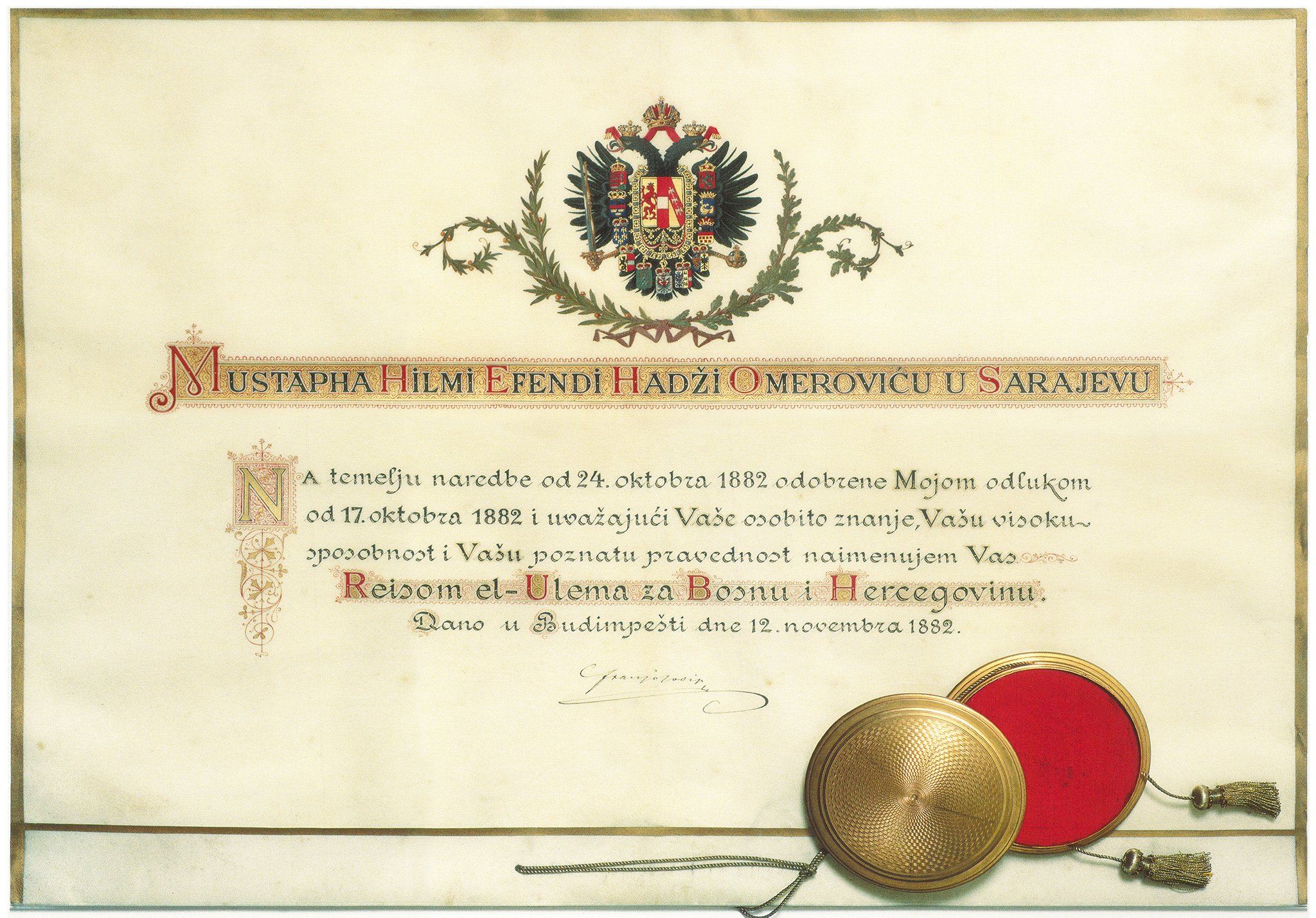
MANSHUR AND THE ISSUE OF LEGITIMACY OF RELIGIOUS LEADER OF THE BOSNIAKS
Author: Fikret Karčić, PhD • Illustration: Appointment decision of reisu-l-ulema Mustafa Hilmi-ef. Hadžiomerović, issued on November 12, 1882 • Source: Gazi Husrev-beg’s Library

“Until 1878, the highest Muslim religious officials in Bosnia were muftis, who enjoyed the rank of “provincial muftis” (kenar muftileri) in the Ottoman learned hierarchy. They were appointed by the Shaikh al-Islam, who issued them a letter of appointment known as manshar. In this respect, provincial muftis acted as delegates of the mufti of Istanbul. During the period of the existence of the office of Shaikh al-Islam in Istanbul (abolished in 1924), the Bosniaks insisted that their raisu-l-ulama receive manshar from Istanbul. After the annexation of Bosnia by Austro-Hungary in 1908 and the severance of political connections with the former metropole, the Bosniaks wished to preserve at least religious connections.
At the same time, Austro-Hungary and all subsequent regimes that ruled Bosnia could not be indifferent to the election of religious leaders of the Bosniaks. The solution to this problem, adopted in the Statute of Autonomy of 1909, evinced a certain division of influence in the electoral process. A special electoral body (Curia) composed of Bosnian ulama' nominated three candidates for the vacant post. The Austrian monarch selected one from among them and appointed him as Raisu-l-ulama. After that, the electoral body, through diplomatic channels, requested from the Shaikh al-Islam that a manshar be issued to the appointed Raisu-l-ulama. The same or a similar procedure was adopted by the Muslims of other Balkan states after the war of 1912-1913.
A new situation emerged after the abolition of the office of Shaikh al-Islam in Turkey in 1924. The Bosniaks united with other Muslims of what constituted the Kingdom of Yugoslavia at that time and found, in 1930, a new solution for the legitimacy problem regarding the post of Raisu-l-ulama. The Constitution of the Islamic Religious Community of the Kingdom of Yugoslavia of 9 July 1930 provided that a special body, composed of Muslim national dignitaries, will issue a letter of appointment to the newly elected Raisu-l-ulama “until the re-establishment of a legal Caliphate”. This “deferment of the Caliphate” (fasile-i hilafet) is still going on.
The practice of issuing a manshar to the religious leader of the Bosniaks after the abolition of the office of Shaikh al-Islam in Istanbul is a unique case among the Muslims in the Balkans, and perhaps wider. The other Muslim minorities, even when they did have commonly accepted religious leaders, did not insist that the latter be provided Shari’ah-based legitimacy, even if symbolic.
Manshur
A manshur is a formal document confirming that a given person is legally appointed or elected Raisu-l-ulama and, as such, is authorized to issue, according to the Shari'ah, similar letters of appointment to subordinate religious officials in Bosnia. This term has come into the parlance of Bosnian Islamic administration via the Ottoman institutions and the Ottomans, in turn, had inherited it from previous Muslim states.
The term manshur (from the Arabic nashara) in Muslim diplomatic history means 'a certificate, an edict, a diploma of appointment'. In different Muslim states throughout history, documents under this name may be found to refer to diverse activities and professions. During the Fatimids, for instance, lecturers were appointed by manshur. In the time of Ayyubids the heads of the notables (nekib el-ashraf) and provincial governors received a manshur. A well-known Hanafi iurist al-Hasan Ibn al-Mansur al-Farghani (died in 592 Hijri year) mentioned a manshur as a document certifying the appointment of a qadi.
In Ottoman administrative practice the term manshur was used side by side with berat and misal. The provincial muftis, including those in Bosnia, were appointed by the issuing of a manshur. In international conventions on the status of Muslims in the Balkans after 1912-1913, the term manshur was used to denote a letter of appointment issued by the Shaikh al-Islam to national Muslim leaders (Grand or Chief Muftis) after their appointment or election at a nation level. The term was used with the same denotation in the Statute of Autonomy and, later, in practice in Bosnia.
The text of the manshur, in Bosnia, has undergone changes during the last century. Generally speaking, the texts of the earlier manshurs are much closer to their Ottoman model. The text of later manshurs, especially those from the communist period, have been modified significantly, in a way that reflects the marginalization of the role of Islam in the social life of the Bosniaks.
Newly-elected Raisu-l-ulama traditionally receives a manshur at the ceremony of investiture held at al-Ghazi Khusraw Bey Mosque (built in 1530-31) in Sarajevo. In the presence of Bosnian ulama, believers, state officials and dignitaries of other confessions. A special place among the invited guests belongs to the high representatives of the Islamic institutions from abroad. The presence of such a large number of “witnesses to the act” (shuhudul-hal), in a manner of speaking, is understood among the Bosniaks as a recognition of the legitimacy of their religious leader, and of the belonging of the Bosnian Islamic Community to the global Muslim Ummah.“
Source:
Karčić, Fikret (2011), „Služba reisul-uleme kod Bošnjaka“, Studije o šerijatskom pravu i institucijama, drugo dopunjeno izdanje, Sarajevo: El-Kalem i Centar za napredne studije, 2011, pp. 317-319. Source: (English version of the text) Intellectual Discourse, 1997, vol. 5, no. 2, pp. 109-120.
